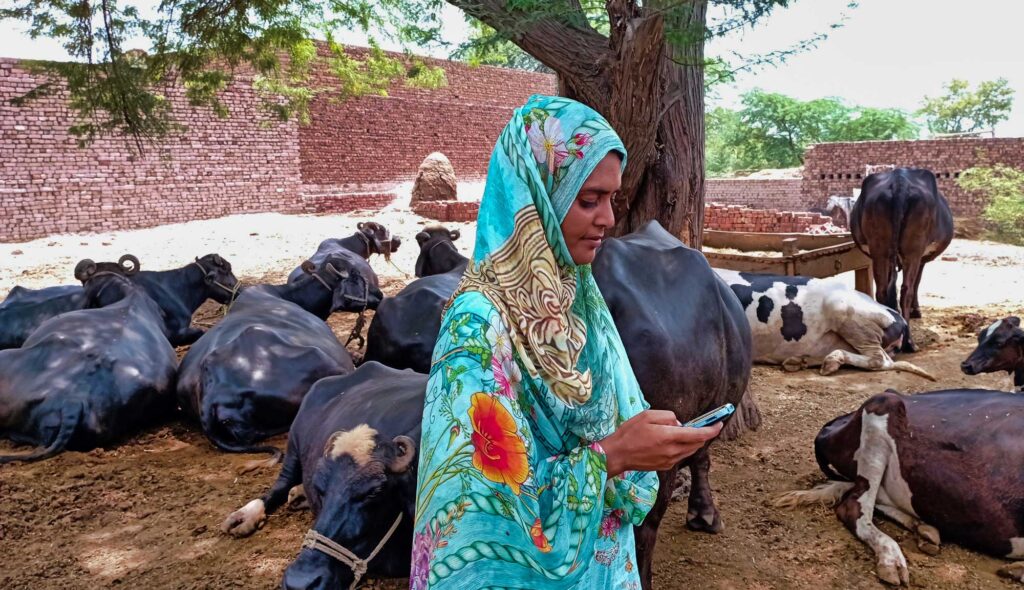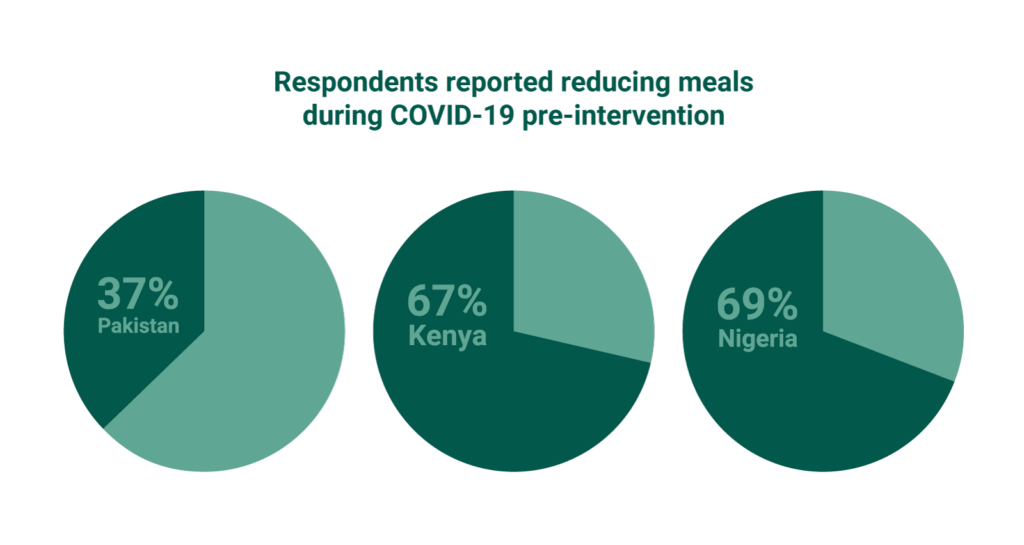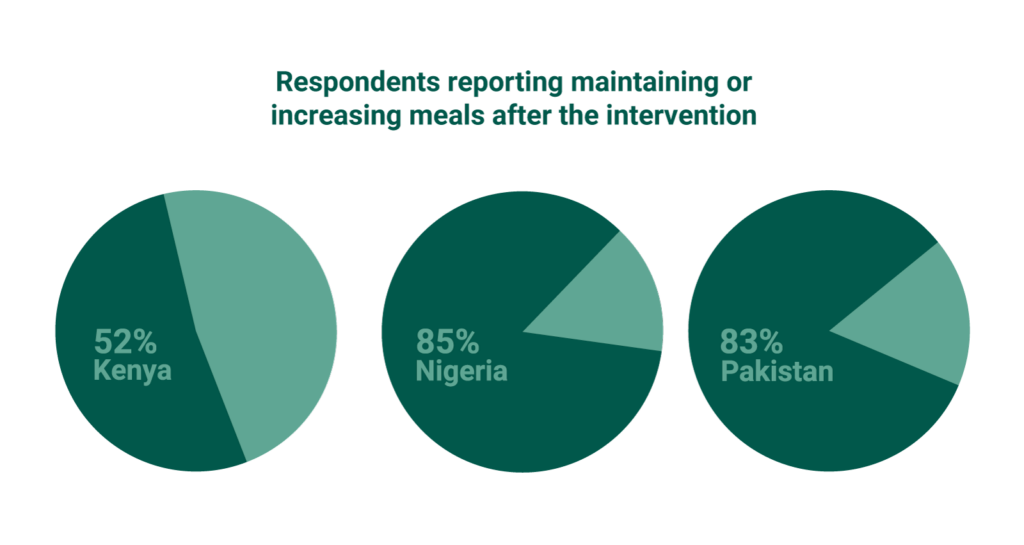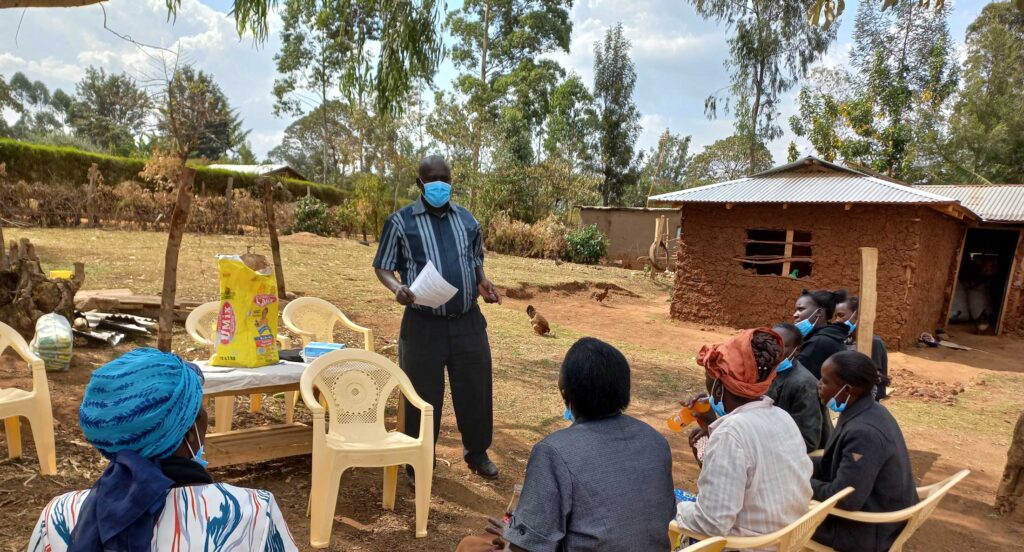Have farmers bounced back from the initial shocks of the COVID-19 pandemic? Results from a multi-country analysis
- July 25, 2022
- 11 minutes read
Given existing poverty, dependence on agriculture for livelihoods, and lack of access to safety nets, poor smallholder families in low- and middle-income countries are particularly vulnerable to exogenous shocks. In March 2020, when the world shut down and told people to stay home to mitigate the public health impacts of COVID-19, many poor smallholder families were left reeling. In response to the growing humanitarian crisis, in April 2020 the International Fund for Agricultural Development (IFAD) launched a multi-donor COVID-19 Rural Poor Stimulus Facility (RPSF) to improve food security and resilience among poor rural people during the pandemic.

PxD was one of several RPSF grant recipients and interventions selected, all of which focused on either digital services, providing inputs or assets, access to markets, or targeting funds for rural financial services. In collaboration with the IFAD country teams and their government partners, PxD implemented three digital advisory services in Kenya, Nigeria, and Pakistan between August 2020 and September 2021 to provide digital extension services to approximately two million users. PxD reached 1.2 million farmers in Pakistan, 650,000 in Kenya, and 100,000 in Nigeria, surpassing the initiative’s target of 1.7 million farmers. This includes roughly 178,000 IFAD project beneficiaries across the three countries. These farmers received timely, relevant, and customized agricultural recommendations to improve their farm productivity directly via their mobile phones.
After successfully launching the initial digital services and delivering agricultural advice, IFAD and PxD conducted RPSF rapid assessments in late 2021 to assess farmer outcomes in all three countries. The surveys were designed to compare production, sales, income, food security, and resilience outcomes after the onset of COVID-19 but before the digital advisory intervention (the pre-intervention period) and after the intervention (the post-intervention period). We define resilience as the ability to cope with unexpected challenges and shocks, such as the ability to deal with drought/floods, pest invasions, and rising input prices. The final sample sizes for Kenya, Nigeria, and Pakistan were 400, 395, and 600, respectively. We stratified the samples by gender, youth status.Youth was defined as heads of households under 35, agro-ecological zone (AEZ) or state1Agro-ecological zones were used in Kenya and Pakistan; the survey covered seven (including unknown) and five AEZs, respectively. We stratified by seven states in Nigeria., and engagement level Kenya and Nigeria only, where we differentiate between high and low engaged users using the median number of messages or calls responded to. so we could analyze and compare outcomes by these subgroups. Within a country, we tested for statistical significance of crop, livestock, poultry, and agribusiness production and sales, as well as food security and income indicators between the pre-intervention and post-intervention period. The samples of farmers selected for the intervention and the surveys were randomly selected from our user bases of IFAD beneficiaries within each country, which may not be nationally representative. Moreover, this is a descriptive analysis, and we cannot infer whether PxD’s services had a causal impact on outcomes reported after the intervention because of the lack of an experimental design (there was no control group).
Farmer-reported outcomes during COVID-19, pre-intervention
Across all three countries, most respondents reported a loss or reduction in production, sales, number of meals, and resiliency during COVID-19 prior to PxD’s RPSF intervention (pre-intervention period). Respondents from Pakistan seemed to be the least affected by the onset of COVID-19, as fewer respondents reported reductions or losses, compared to Nigeria or Kenya. Moreover, almost half as many respondents reported reducing meals (37%) than in Kenya (67%) or Nigeria (69%). For all indicators except food security, respondents from Kenya reported the worst outcomes, including over 98% who reported lost or reduced production during COVID-19. There was also a wide disparity between the percentage of respondents reporting selling assets across the three countries. Almost two-thirds (65%) of respondents in Kenya reported selling assets because of COVID-19, whereas less than 10% of respondents in Nigeria reported the same.

We also disaggregated production and sales outcomes by specific types of farming that farmers engage in, namely: crop growing, livestock rearing, poultry raising, and agribusiness activities. We find that agribusiness production and sales suffered the most in Pakistan when compared to crop, livestock, and poultry. This finding could be attributed to COVID-19 restrictions which limited the ability to engage in business activities. However, in Kenya and Nigeria, farmers reported larger reductions in crop production and sales compared to livestock, poultry, or agribusiness.
While respondents in Kenya overall seemed to fare the worst in the pre-intervention period, Kenyan women suffered disproportionately more. For example, all Kenyan women reported a reduction or loss of production during the pandemic, and women reported higher reductions than men for all other indicators. We don’t see the same clear pattern in Nigeria or Pakistan, although more women from all three countries reported worse food security outcomes than men. This could in part be due to cultural expectations of women eating last and in small portions, compared to men in the same household.
… and post-intervention
After the RPSF intervention concluded in late 2021, during a lull in the COVID-19 pandemic between the Delta and Omicron waves, we observed encouraging evidence of improved farmer resilience. Respondents in all three countries indicated that conditions had improved relative to the early phase of the pandemic, at the onset of COVID-19 but before the digital advisory intervention (the pre-intervention period), however, some fared better than others. For example, Nigerian respondents reported maintaining or improving production, sales, income, meals eaten, resilience, and asset indicators at higher rates than those in Kenya and Pakistan. Considering the poor conditions they reported during COVID-19, we take this as a sign that Nigerian respondents may have recovered from the pandemic more quickly than their counterparts in Kenya and Pakistan. Conversely, in addition to suffering the worst outcomes in the pre-intervention period, Kenyan respondents indicated that they maintained or improved outcomes the least in the post-intervention period. Only about half of Kenyan respondents reported production and meals were maintained or increased, and less than half reported maintaining or increasing sales, income, resiliency, and assets. Only 25.5% of Kenyan respondents reported income stayed the same or improved, highlighting that Kenyan farmers have struggled significantly in recovering from the pandemic, even after receiving the intervention.

Kenya experienced severe drought during the long rains 2021 season (February-March to June-August depending on location) while the RPSF intervention was underway and during the collection of this data, which likely contributed to the poor outcomes reported after the RPSF intervention. For example, many farmers reported failed crops rendering it impossible to follow the customized digital advisory of the intervention, and to harvest and sell their crop. This is corroborated by reports estimating reduced crop production of up to 70% in Kenya during the drought2Oxfam International, 2022 https://www.oxfam.org/en/press-releases/many-28-million-people-across-east-africa-risk-extreme-hunger-if-rains-fail-again.
Disaggregating the results by type of farming activity, we find that Kenyan and Pakistani farmers reported production and sales reductions in agribusiness the most, even after the RPSF intervention. Because COVID-19 restrictions imposed by the government persisted during the intervention and survey period, we suspect that these restrictions played a role in farmers’ ability to engage in agribusiness, resulting in lower production and sales than other farm activities. In Nigeria in the post-intervention period, farmers reported reductions in production and sales for crop farming more than the other surveyed farm activities, suggesting that even though there were improvements to production and sales after the intervention, farmers’ crop yields suffered the most, relative to their livestock, poultry, and agribusiness activities.
In Pakistan, we observe better outcomes than in Kenya, although slightly less than half (48%) of respondents indicated they maintained or improved their income after RPSF, and only slightly more than half (57%) reported maintaining or improving their sales. Greater than expected wheat yields might have contributed to the better outcomes observed in Pakistan. But while these figures are somewhat encouraging and indicate that some Pakistani farmers were able to recover from COVID-19-related shocks, it also indicates that a significant share of farmers has not recovered. This could be because of the lingering effects of COVID-19 such as global trade shocks and new variants disrupting economic activity via additional lockdowns.
Similar to the outcomes reported during COVID-19, Kenyan women respondents indicated they maintained or improved outcomes less than their male counterparts after the intervention, across all indicators except assets. Only 17.3% of women reported maintaining or improving their income after RPSF, which is almost half the proportion for men, highlighting the predicament of women in Kenya in the face of COVID-19 and drought-related shocks. In Pakistan, while overall outcomes were better, we still note women reported maintaining or improving production, sales, income, and meals at lower rates than men. In Nigeria, a higher proportion of women actually reported maintaining or improving income, meals, and resiliency, and for the other indicators, women reported maintaining and improving at similar rates to Nigerian men. However, we also found evidence that women were disproportionately affected in the livestock sector; Nigerian women were more likely to report reductions in livestock production and sales after RPSF, compared to their male counterparts. Across all three countries, women reported faring worse than men in maintaining or increasing sales.

We also disaggregated the post-intervention RPSF results by farmers’ level of engagement with the PxD service, where we defined highly engaged users as having picked up or responded to more than the median number of calls (Nigeria) or SMS messages (Kenya)3We did not disaggregate by level of engagement in Pakistan.. In Kenya, we did not see any clear patterns by engagement level. However, in Nigeria, we found that highly engaged users (who picked up more than seven calls) reported maintaining or improving production, sales, and income at a higher rate than lower engaged users. This result provides suggestive evidence to our theory of change that users who more actively engage with our services may implement more of (or implement better) our recommendations, leading to improved outcomes.
It was challenging to draw clear conclusions from the data at the level of agro-ecological zone and state, due to the small number of respondents per zone or state. For example, in Kenya, there is some evidence that households from the upper highlands (UH) AEZ fared better than respondents in other zones. This may be because the UH zone was less affected by severe drought than other more arid regions in the country. In Nigeria, respondents in Katsina fared worse than the other states, reporting the highest level of reductions in most production, sales, food security, and resiliency measures. We suspect that local terrorism and banditry in the state played a role in the poor outcomes reported there. Meanwhile, respondents in the Nigerian state of Jigawa reported faring the best, which may be because widespread telecommunication shutdowns that plagued the country during the grant period were avoided, and the state is relatively peaceful compared to others in the north.
While the initial COVID-19 shock occurred in early 2020, the results of the surveys suggest that there are strong lingering negative effects in all three countries (as well as other severe shocks such as extreme weather events and terrorism) and more direct support is needed to return smallholder farmers to their pre-COVID-19 state. While this analysis does not estimate the causal impact of PxD services, we plan to use the data from this analysis to improve our services to more effectively meet farmers’ needs. In Kenya, we hope to specifically address weather-related shocks such as severe drought. Weather-related services are already being explored in Pakistan and India and learnings from these pilots might also be applicable in Kenya. Based on the evidence that women found it more difficult to cope and recover from COVID-19, we hope to develop women-targeted interventions designed to reach more women users or develop content tailored to women’s needs. This will build on gender-focused service experimentation we have undertaken such as providing messages with a female narrator and nudges encouraging spouses to share PxD advisory with each other, as well as implementation of advisories focused on female-dominated value chains such as kitchen gardens, dairy, and livestock.
Since the conclusion of the intervention and endline survey, farmers’ situations have become even direr. Experts warn of rising food shortages and hunger due to high global inflation and supply chain disruptions caused by the war in Ukraine. The World Bank estimates that the Agricultural Price Index is 14% higher as of this June compared to January and 94% of low-income countries are experiencing food price inflation greater than 5%. The already looming food crisis is expected to be exacerbated by a sharp increase in fertilizer prices, largely driven by the war in Ukraine, as Russia and its ally Belarus produce 40% of the world’s supply of potash, and Russia and Ukraine together export 28% of nitrogen and phosphorus-based fertilizers. Within this context and amid the backdrop of the ongoing pandemic, the need for strong support for poor smallholder families is urgent.

Stay Updated with Our Newsletter

Make an Impact Today


